This is the default narration at loading ...
Contents here



Pompeii
A day was set aside to travel south and experience the amazing city of Pompeii.
Built on an ancient lava plateau next to the volcano of Vesuvius some one thousand years ago, Pompeii was a thriving community until the fateful day of 24 August 79 AD when it was buried under a 5-6 meter deep pyroclastic flow from the suddenly erupting volcano.
Soon completely forgotten, Pompeii's ruins lay dormant and hidden for almost 1,700 years until excavations commenced around 1800, followed by more scientifically proper ones in 1860.
But Pompeii's disastrous fate allows us today to stroll through the streets of this ancient city and visit 2,000 years old houses, which look like they were abandoned by their occupants just a few days ago.


Abbey of Monte Cassino
But wait. On your way south from Rome to Pompeii you will pass the infamous Abbey lodged on the peak of Monte Cassino.
This abbey played an ill-fated role in the drive by the allied forces to oust German troops from Italy in early 1944.
Strategically placed on the peak with a wide ranging view of the surrounding landscape, the allies mistakenly believed that it was occupied by German forces and called in a massive air bombardment, which killed most of the many woman and children sheltering there from the war.
After the bombardment the Germans actually did occupy the ruins and managed to hold the allied forces at bay for almost three months until finally withdrawing on 18 May 1944.


Front Terraces Pompeii
Back to Pompeii. The photo shows some of the terraced buildings on the front outside part of the ancient city.
Founded by the old Osci peoples of Italy in the 8th Century BC, the city was strategically located on the only north-south land route and also offered a seaport for the produce grown in the valleys behind it. The Osci peoples were called "gens pompeiana" and their name has stuck to the city ever since.
Such a well placed city invites for control by powerful states and as could be expected, the city was in turn conquered by the Greeks, the Etruscans, the Samnites and, finally, by the Romans around 300 BC.


Seaside City Gate
The seaside entrance to Pompeii seen from the inside. Straight ahead is the opening used by carts whereas pedestrians used the stairs on the right (hidden behind the tall pillars).
The city had developed into a thriving trading and industrial center by the time it was struck by a major earthquake in 62 AD. The earthquake left most of the buildings in ruins and a major restoration commenced.
The earthquake was but a harbinger of worse to come, but nobody saw the writing on the wall. Vesuvius was still considered an extinct volcano and completely unaffected by the earthquake. Just 17 years later that perception proved fatally wrong.


The Basilica
The basilica is one of the oldest buildings in Pompeii and is accessed directly from Forum, the main public square.
The large roofed hall measured 24 x 55 meters and originally served as a market. By the time of the eruption in 79 AD it was mainly used for disposing of legal matters. The Tribunal in the background was erected at that time and was the seat of the law courts.

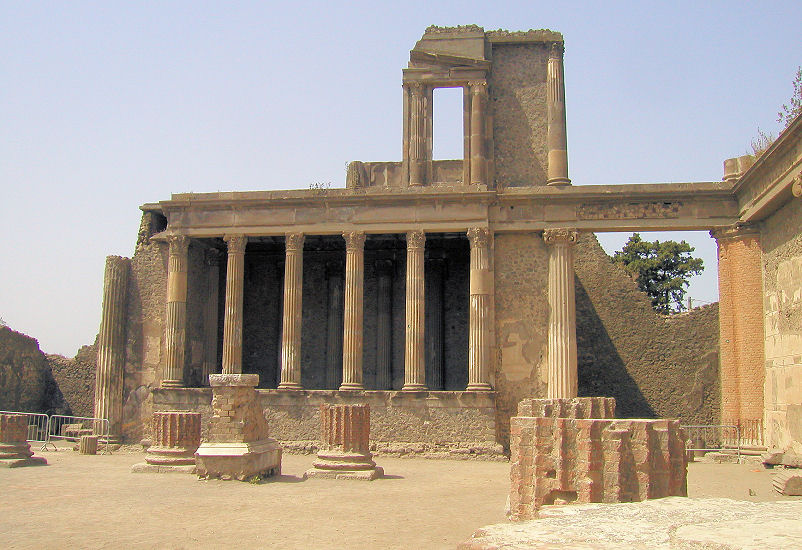
The Tribunal
The seat of the law courts, this structure was erected in the 1st Century AC.
From the 5th century AD and onwards Pompeii was divided into nine main sections by two streets running lengthwise and two streets running crosswise.
Most of the common buildings were naturally located just inside the main seawards city entrance, centered around the Forum or main square.


The Forum
Measuring 38 x 157 meters, Forum was the religious, political and social center of the city.
The pedestals in the front of the photo were the bases for statutes of Nero, Agrippa, Augustus and Claudius. The two arches in the background are the arch of Germanicus (left) and Tiberius (right).
Some of the buildings surrounding the Forum were the fabric market, the grain market, public toilets, the temples of Vespasian, Apollo, Jupiter and Augustus, the Municipal Council, the City Government, the Basilica et al.
In the middle of one side of the Forum was the tribune for speakers -a precursor for "Speakers' Corner". The large building in the center back between the two arches is the Temple of Jupiter.
Note the very active Vesuvius looming in the horizon.
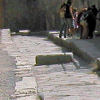

A quiet, local road
The large stone blocks in the middle of the roadway are pedestrian crossings -necessary because most roads (and houses) had no sewers.
This particular road is quite narrow and possibly one-way since carts would not be able to pass each other.


Wall paintings
The painting style stems from the period 100 BC through 79 AD, characterized by being murals with framing of some sort of architectural style.
The earlier emphasis on realism, depth and three dimensional impression has given way to more simplistic styles, migrating into smaller pictures and less and less realism.
The house itself is that of a less well-to-do owner or occupant.
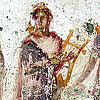

Wall paintings
This mural probably stems from around year 0.


Wall paintings
Far more realism, story telling and an attempt at creating depth combine to date this mural to a period around or a little before 100 BC.
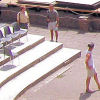

The Large Theatre
Originally constructed around 3rd century BC, this theatre can seat up to 5,000 spectators.
The lower stone seats were reserved for the most prominent guests. As with the amphitheater, the higher up the seat, the poorer or of a lesser class you were.
The separate spectator boxes built over the arched side entrances were reserved for priestesses and for the citizen presiding over the performance.
The stage -on my photo under preparation for a modern performance- was made of brick as was the backdrop structure, which was originally covered with painted colonnades, statutes and fountains.
Behind the stage structure are the ruins of the square arcaded court.
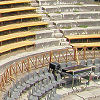

The Large Theatre
The seating section. Made of stone, the curved and slanting construction created a superb acoustics irrespective of where you sat.
The entire theatre was covered by a huge canopy attached to the back with large poles (left, top on photo) to give shelter from the sun and wind.
The strictly stratified seating aligned with social status has not changed much over time. Note that for the modern performance under preparation there are individual chairs for the important visitors (gray chairs, lower right) whereas all other people sit on the wooden benches separated from the front section with a rail.
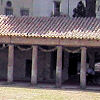

The Arcaded Court
This structure, located right behind the Large Theatre, forms a perfect square and has colonnaded arcades (originally) covered with pyramidal roofing.
The court was originally used by the spectators to the Great Theatre for socializing before the performance and during the intermissions, but after 62 AD, the year of the devastating earthquake, it was converted into barracks for the many gladiators fighting in the amphitheater.
The photo looks south and the still roof-covered south wing is in the background.
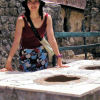

Have a rest
Along the roads were many small cafés where one could stop for a quick refreshment.
The large holes held the 'ampforas' -the highly popular ablong, pointed containers used in those days for storing liquids.
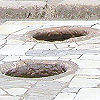

Early Starbucks?
These small cafés had a limited menu and were mostly intended for a quick stop-by refreshment, as opposed to the small restaurants, which had a wider range of product to offer.

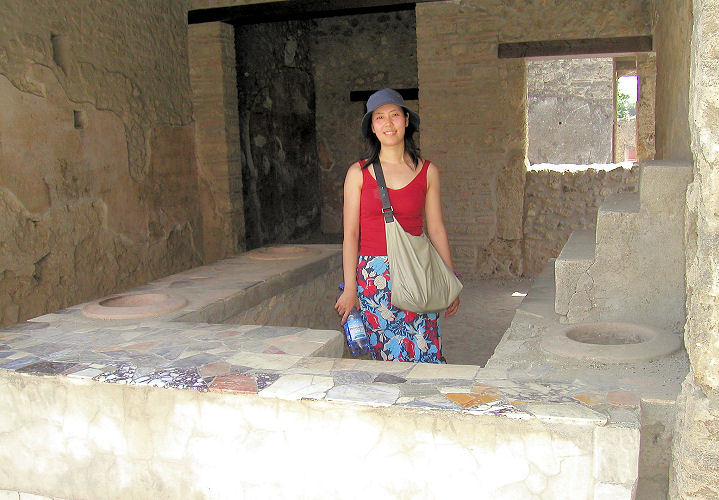
Taverns
We have moved to one of the many small taverns.
They offered a wide selection of foods and drinks evidenced by the many holes in the tables for containers.
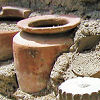

Taverns
The eruption was so sudden and powerful that the innkeeper left all his products behind, still today stacked in the back of the store.
Taverns would serve food and drinks downstairs and then offer female company on the upper floor.

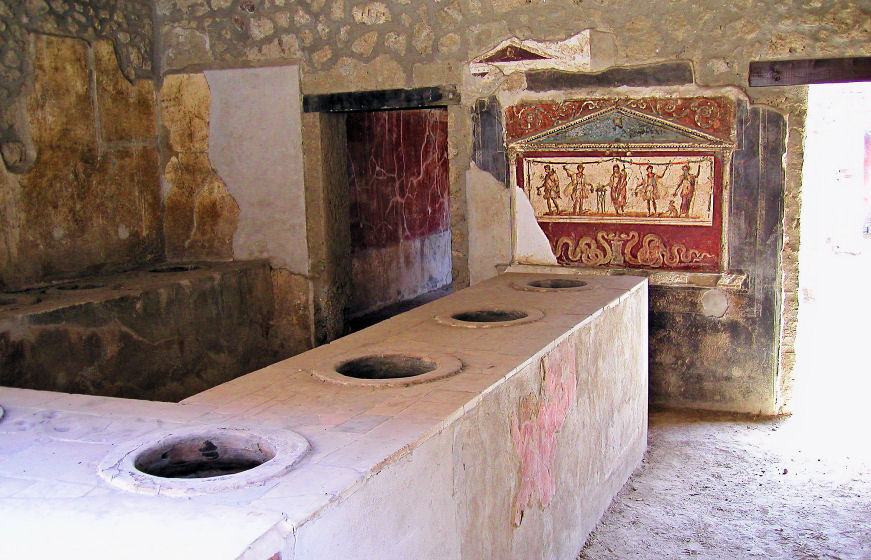
Taverns
Inside the tavern of Asellina.
Fast food, cold and hot drinks were all on the menu judging from what was left behind.
Inscriptions on the walls indicate that female company could be arranged on the upper floor in small alcoves.
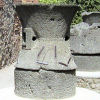

Bakery of Modesto
A visit to the local bakery -like everything else evacuated in a hurried panic.
Left is the oven (see also next photo), but in the center is one of several mills, made from volcanic rock.
Each mill had two parts. At the bottom a conical rock and on top a biconical rock, hollow at the top.
Mules or slaves would keep the mills turning, grinding between the two rocks corn slowly poured in from the top.
The resulting flour was collected at the base, originally encased by a lead sheet.
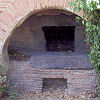

Bakery of Modesto
The baker's all important oven.
The door to the oven was made of heat resistant lava stone covered with iron.
The baker burned wood for heating and the oven was covered top and bottom with sand to reduce heat loss.
On the left is a basin, which would be filled with water. The water was used to cool the shovel as also to generate a warm, glossy surface on the bread.
All in all, the bakery and its tools are relatively simple and primitive.


Modern Tavern
Time for a quick bite.
Click on 'Other Galleries' to see more photos from Pompeii.